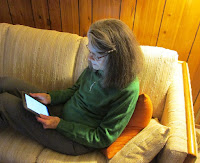Text copyright © 2016 by Carol
Stone. Photos © 2016 by Thane Puissegur and Carol Stone.
 |
| Drinking coffee in magnificent surroundings |
Once a coffee
addict, always a coffee addict. What was good enough for Voltaire and Balzac is
certainly good enough for a hack writer like me. I need three cups of coffee a
day wherever I am, including wherever the RV is. This is a common problem, as
evidenced by the many comments online about making coffee while traveling.
Some RV
manufacturers have tried to respond by installing electric coffeepots under the
galley cupboard, but apparently that has been a failure. The appliances use too
much precious counter space, and are no better than any electric coffeepots,
and so some RV owners have had the pots removed at their own expense. In my
opinion most shore-power electricity is a silly luxury for big rigs, anyway.
For most of us at least part of the time, propane or campfire pots are needed.
What other
solutions are there? Of course, there are always old-fashioned metal percolators
that have the advantage of using propane rather than electricity. These are also
inexpensive and easy to use, but they can add a metallic taste to the brew. I
haven’t used one in decades.
At home, I prefer
using a Melitta eight-cup cone with a glass carafe, having some in the morning
and reheating the rest as needed in the microwave; on the road I use a space-saving
small cone and matching ceramic mug. This is only good for a cup or two at a
time, though. The Melitta cone and travel mug combo shown online looks appealing:
https://shoponline.melitta.com/product/pour-over-travel-mug-set-red/pour-over-coffee-makers.
Again, however, this probably makes only a small amount at a time. What I
really want is to make at least three or four cups in the morning, and to save
some for later. A Thermos bottle will keep it hot without the need for a
microwave.
French
presses make excellent coffee and are
popular with many people. I had one for a while but quickly broke two of the very
fragile carafes and realized they were impractical for RV use. I like the lack
of paper filters, though, and may buy a shatterproof type some time. One online
model has a stainless steel carafe. Another one has a plastic one that has
received bad reviews.
The brand of
coffee can make all the difference in quality. Much as I like the ambiance of
Starbucks coffee shops, I don’t think much of their coffee, and Peet’s coffee
is too powerful even for me. Years ago I visited New Orleans and learned to use
French Market coffee, which is part chicory. Though the delicious black brew is
strong, it has less caffeine than pure coffee; I mix it with milk for a smooth
but robust drink. At home I often first heat the milk, as they do in New
Orleans; on the road I make do with cold milk. Incidentally, it is hard to find
the brand in many places. Raley’s supermarket sells it in my home area, so I stock
up on it before traveling.
Coffee grounds are a messy part of RV life, just as they are at
home. They should never be put down the
drain! That’s a good way to clog the delicate plumbing in an RV or to overload
a campground septic tank. Even in an urban situation, they can build up in a
drain and lead to plumber’s bills. At home, I put the grounds and filters in a
compost bin, or put the grounds near plants in the garden. Sadly, I’ve never
seen a compost bin in a campground (regular or Wal-Mart), and must put the
grounds and filters in the trash. If I’m far out in a forest where the plants
can benefit, I put the grounds out of sight somewhere far from where anyone
will camp or walk.










